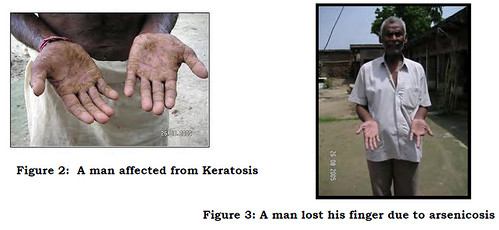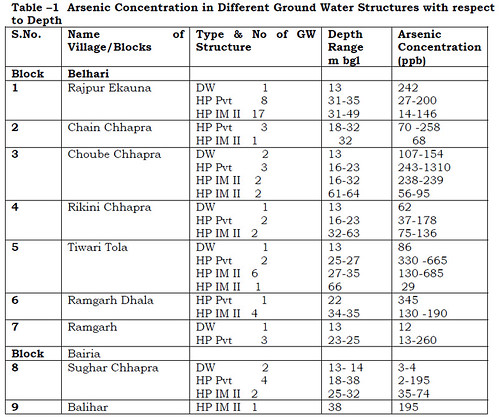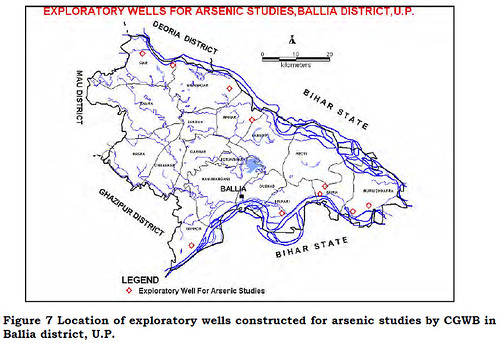INTRODUCTION
The risk management of geo environment and its impact on the ground water is thepresent day concern all over the world. Evaluation of the vulnerability of humanpopulation has a special significance in designing area specific appropriate mitigationmeasures. The present study deals primarily with the arsenic contamination in parts ofBallia district : an alarming problems and its remedial measures.
The Ballia district is eastern most part of Uttar Pradesh State lies between 250 33’ and 260 11’ north latitude and 830 38’ and 840 39’ east longitude. It is in Central Ganga Alluvial Plain situated in doab of river Ganga and Ghaghra. For the administrative function district is divided into seventeen blocks and six tehsils. ( Figure 1)The total geographical area of the district is 3168 Sq Km. The average annual rainfall is 947 mm. People are depend on handpumps for drinking water.
 Observations have revealed high concentration of Arsenic (> 50 ppb) in ground water ofphreatic aquifer in younger alluvium of Ganga and Ghaghra rivers along meanderingcourse. People of village Rajpur Ekauna, Chain Chhapra, Tiwai Tola, Sughar Chhapra, Chaube Chhapra are suffering from various stages of arenicosis. The exploration programme has been taken up (CGWB) in view to accelerate potable water and study ofhorizontal and vertical distribution of arsenic in different aquifer system in the area and to control the health hazard due to arsenic in ground water.
Observations have revealed high concentration of Arsenic (> 50 ppb) in ground water ofphreatic aquifer in younger alluvium of Ganga and Ghaghra rivers along meanderingcourse. People of village Rajpur Ekauna, Chain Chhapra, Tiwai Tola, Sughar Chhapra, Chaube Chhapra are suffering from various stages of arenicosis. The exploration programme has been taken up (CGWB) in view to accelerate potable water and study ofhorizontal and vertical distribution of arsenic in different aquifer system in the area and to control the health hazard due to arsenic in ground water.
HYDROGEOLOGICAL ENVIRONMENT
 The area falls in Central Ganga Plain underlain by thick sequence of Quaternarysediments comprising Clay, Sand, Silt and Kankar. Geomorphologically area is dividedinto Younger and Older alluvium. The ground water exploration (C.G.W.B) in the district(down to 750 m bgl) reveals three tier system of aquifer. The ground water occurs underunconfined condition in phreatic aquifer and confined condition in deep aquifer. Thedepth to water level in pre monsoon period varies from 3.50 m to 9.8 mbgl. In postmonsoon period it varies from 1.8m to 8.0 mbgl. The different grades of sands are themain granular zones in the area. The yields of the tubewells tapping shallow aquifervary from 35-100 lps with draw down between3.0 to14.0 m. The yields of the deeptube wells range between 30 to 50 lps with draw down ranges between 2.0 to11.0 m.The water table contours shows flow of ground water towards Ghaghra in northernparts and towards Ganga in southern part of the district. Hydrological map of thearea is given in Figure 4.
The area falls in Central Ganga Plain underlain by thick sequence of Quaternarysediments comprising Clay, Sand, Silt and Kankar. Geomorphologically area is dividedinto Younger and Older alluvium. The ground water exploration (C.G.W.B) in the district(down to 750 m bgl) reveals three tier system of aquifer. The ground water occurs underunconfined condition in phreatic aquifer and confined condition in deep aquifer. Thedepth to water level in pre monsoon period varies from 3.50 m to 9.8 mbgl. In postmonsoon period it varies from 1.8m to 8.0 mbgl. The different grades of sands are themain granular zones in the area. The yields of the tubewells tapping shallow aquifervary from 35-100 lps with draw down between3.0 to14.0 m. The yields of the deeptube wells range between 30 to 50 lps with draw down ranges between 2.0 to11.0 m.The water table contours shows flow of ground water towards Ghaghra in northernparts and towards Ganga in southern part of the district. Hydrological map of thearea is given in Figure 4.OCCURRENCE AND DISTRIBUTION OF ARSENIC IN GROUND WATER:
In September 2004, presence of high arsenic symptoms in human body of the peoplefrom Rajpur Ekauna, Chain Chapra , Ramgarh Dhala,Sughar Chhapra villages in Balliadistrict has been reported . The blood sample of Sh. Dina Nath Singh of Rajpur Ekaunavillage had 34.4 ppb of arsenic where as the reference limit is mere 1.4 ppb. Thepresence of high Arsenic in blood can only be possible in case of chronic exposure.
 In September 2004, water samples were collected from different abstraction structuresi.e. dugwell, handpump State & CGWB tubewell and Ganga River. Out of 144 samples 65 have Arsenic concentration above 50 ppb. No Arsenic concentration has been reported from all three exploratory existing tubewell of CGWB. The maximum occurrence of arsenic is reported from handpumps (depth Range 27 –66 m bgl). All the arsenic affected handpumps are located in younger alluvium in Belhari ,Baria, Dubhad, Murli Chchapra,Reoti, Sohaon, Maniar and Siar Bloicks.The highly arsenic infested villages are Rajpur Ekauna , Chain Chchapra , TiwariTola, Choube Chchapra (Belhari Blocks) and Sughar Chapra, Ramgarh (Bairia Block). Maximum arsenic concentration observed at Choube Chchapra is 1310 ppb. Figure 5 and Table 1 &2 illustrates the vertical and horizontal distribution of arsenic in ground water in the study area.
In September 2004, water samples were collected from different abstraction structuresi.e. dugwell, handpump State & CGWB tubewell and Ganga River. Out of 144 samples 65 have Arsenic concentration above 50 ppb. No Arsenic concentration has been reported from all three exploratory existing tubewell of CGWB. The maximum occurrence of arsenic is reported from handpumps (depth Range 27 –66 m bgl). All the arsenic affected handpumps are located in younger alluvium in Belhari ,Baria, Dubhad, Murli Chchapra,Reoti, Sohaon, Maniar and Siar Bloicks.The highly arsenic infested villages are Rajpur Ekauna , Chain Chchapra , TiwariTola, Choube Chchapra (Belhari Blocks) and Sughar Chapra, Ramgarh (Bairia Block). Maximum arsenic concentration observed at Choube Chchapra is 1310 ppb. Figure 5 and Table 1 &2 illustrates the vertical and horizontal distribution of arsenic in ground water in the study area.
 As per analysis of ground water samples and distribution pattern that high concentration of As is observed in phreatic aquifer in younger alluvium along meandering course of Ganga and Ghaghra River.
As per analysis of ground water samples and distribution pattern that high concentration of As is observed in phreatic aquifer in younger alluvium along meandering course of Ganga and Ghaghra River.Permissible Limit
Earlier maximum permissible limit of arsenic for drinking water was 50 ppb. RecentlyWorld Health Organisation has reduced its permissible limit to 10ppb for drinking waterpurpose. In India, Department of Drinking Water Supply Ministry of Rural Developmenthas yet its 50ppb to be used for time being.
MOBILIZATION OF ARSENIC
As per occurrence and distribution of arsenic in different part of India and abroad (WestBengal and Bangladesh). There are three main theories for mobilization and occurrenceof arsenic in ground water.
Reductive dissolution of iron oxihydraoxide (FeOOH) and release of sorbed arsenic to ground water ( Bhattacharya et al 1997, Nickson 1998,2000,2005 )
1 Arsenic was naturally transported by river system of Himalaya and adsorbed on tofine-grained iron and manganese hydroxide. These are deposited in the flood plain. Andburied in the sedimentary pile of sediments.
2. Microbial oxidation of organic carbon due to occurrence of peat deposits depleted thedissolved oxygen in the ground water thus creating a strongly reducing Environment. (Mc Authur etal 2001)
Oxidation of Arsenical Pyrite ( Acharya et al 1997 )
1 Arsenic is released by oxidation of arsenical pyrite in alluvial sediments sincepumping drawdown permits atmospheric oxygen to invade the aquifer.
2 As the water level rise due to recharge during monsoon arsenic leaches out ofsediments into aquifer.
Anion (Competitive ) Exchange of sorbed arsenic with Phosphate from fertilizer :( Acharya et al 1997)
1 Arsenic anions sorbed to the aquifer minerals are displaced into solution bycompetitive exchange of phosphate anion derived from over application of fertilizer.
2. Withdrawl of ground water for irrigation may have mobilized the phosphate infertilizer and also from decay of natural organic matter in shallow aquifers.
On the basis of analysis of the ground water samples it is suggested that arsenic isreleased in the reducing environment in the study area. ( Chauhan et al 2009)
REMEDIAL MEASURES
1) The problem of Arsenic pollution in ground water in Ballia district has to beimmediately addressed to. The first and the foremost task is to identify the villageswhere Arsenic concentration is above the maximum permissible limit defined by BIS (IS10500 – 91). Arsenic field-testing kit could prove to a very useful instrument tocommence the detailed investigations in these areas. The spot analysis of arsenic byfield Kit and high concentration of arsenic samples are analyzed by AAS in CGWB andJal Nigam
2) The hand pumps yielding water with higher Arsenic concentration may bedemarcated like being painted red etc. These markings would indicate that these pumpsare not fit to be used for catering to human or livestock needs.
3) Alternative sources of ground water may be identified and recommended for use. Theexploratory wells in different aquifer at different places in arsenic affected area of thedistrict has been constructed by CGWB to know the arsenic concentration in differentaquifer. These exploratory well which are free from arsenic may be utilized by JalNigam as production well for drinking water. Till date 10 nos of deep tube well ( downto 350 m bgl) were constructed by CGWB.( Fig. 7) Arsenic free aquifer is separated fromother aquifer by cement sealing within clay layer to check mixing of ground water ofdifferent aquifers. Hydrogeological tests were conducted at different exploratory well andit was found that no effect was observed on other observation when main well waspumped. It shows that there is no link between different aquifer and cement sealingtechnique is properly working. Figure 6 show detail of litholog, cement sealing position

 4) The most important aspect of any pollution study is not to scare but make peopleaware. It is imperative to make people aware of the groundwater structures having highconcentration of arsenic. The objective is to educate them – to use and/or avoidgroundwater structures according to arsenic content in water.
4) The most important aspect of any pollution study is not to scare but make peopleaware. It is imperative to make people aware of the groundwater structures having highconcentration of arsenic. The objective is to educate them – to use and/or avoidgroundwater structures according to arsenic content in water.Acknowledgement
The authors express sincere gratitude to Chairman, Member, CGWB & RegionalDirector, CGWB, NR Lucknow for giving permission to publish this paper.
References
• Acharyya, S. K. et al. : Risk of arsenic contamination in groundwater affecting theGanga Alluvial Plain, India Environ.Health Persp. Corr.112,A-19-A20
• Bhattacharya. P. et al 1997: Occurrence of arsenic contaminated groundwater inalluvial aquifers from delta plains: J. water resource D 13 ,79-92
• Nickson, R. et al: 2000 Mechanism of arsenic release to groundwater, Bangladeshand West Bengal. Appl. Geochem 15, 403-413
• Vivek S Chouhan et al 2009: Ground Water geochemistry of Ballia District, U.P. Indiaand mechanism of arsenic release.
• Gaumat M. M., et al 2005 : Arsenic Hazards and its Mitigation in Ground Water inparts of Belhari and Bairia Blocks of Ballia District,U.P., CGWB Technical Reports.
• Tripathi P. K. Prashant Rai 2009 : Basic Data Report of Exploratory Well at Ramgarh,Ballia District , U.P.
D. S. Pandey, K.K. Singh, P.K. Tripathi, Prashant Rai, P. K. Singh - Central Ground Water Board, NR, Lucknow
Path Alias
/articles/arsenic-contamination-ground-water-alarming-problem-its-remedial-measures-ballia-district
Post By: Hindi